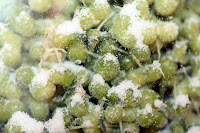Wild Garlic Ramsons, often found in ancient woodlands, and beside river banks, this plant has been prized for centuries. Originally the bulb was eaten, now the leaves are popular, and thanks to chef Enda McEvoy for the tip about preserving the seeds heads as tiny capers.
We won't get to taste the capers for another couple of months, but right now the smell and sight of them sitting in their jars is enough.
First pick your ramsons. You need to catch them just as the flower heads begin to fall, revealing a caper sized seed head. Pick them soon after flowering, before the seed dries. A basketful yields about 250g of seeds.
Then, you begin the long process of de-seeding them. Use a small pair of scissors. Play some music, don't expect to do this quickly.
 When you have the garlic sorted, place in a jar with salt.
When you have the garlic sorted, place in a jar with salt. Leave for three weeks, mark the date on your calendar.
Pour out of the jar into a sieve, and rinse off the salt. Leave for a short while on kitchen paper to dry and then put the ramsons in sterilised jars. Cover with malt vinegar.
Now the waiting again, leave for a few months to mellow and absorb the vinegar. I'll report back then. The approximate quantities for all this is 250g ramson seed heads, 200g salt and 284mls malt vinegar. Makes about four jars.
Thanks to Enda McEvoy for the knowledge. Enda is opening a new restaurant, Aniar, in Galway very soon.
@endamcevoy
Aniar Restaurant
Cook Wild






Great photos Sally thank you! Something I did for first time this year on seeing a photo of Enda's via twitter. Although I missed the salting step so I understand better now....will just have to wait until next year.
ReplyDeleteLet us know how you get on, and if there's anything else you think is good for pickling. We missed out on nasturtiums this year, but the pickled elderberries were the best!
ReplyDeleteIs there anywhere these can be purchased. I've just got Simon Rogans new cookbook and I can't wait to try things. Unfortunately it's November. There's not a lot out there in the hedgerows.
ReplyDelete